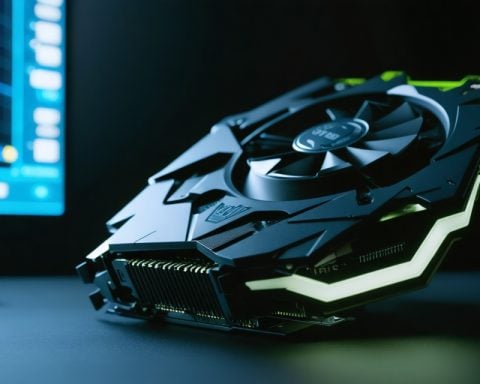- Nvidia’s RTX 50-series graphics cards, including the RTX 5090 and RTX 5070 Ti, are facing performance issues and malfunctions, affecting around 0.5% of units.
- The problem stems from some cards being shipped with fewer ROPs, which are essential for rendering high-quality graphics.
- One user reported severe damage when their card caught fire, illustrating the seriousness of the issue.
- The root of the issue is tied to defects in Nvidia’s Blackwell architecture, which cannot be fixed with software updates.
- Nvidia is offering replacements for affected cards, and tools like TechPowerUp’s GPU-Z can help users identify faulty units.
- The situation underscores the challenges of quality assurance in high-end gaming technology and the risks of early adoption.
A simmering controversy brewed around Nvidia’s much-anticipated RTX 50-series graphics cards, as frustrated gamers encountered unexpected performance stumbles and hardware malfunctions. Echoing whispers across tech forums revealed a troubling flaw affecting a sliver of RTX 5090 and RTX 5070 Ti cards. These premium cards, adorned with cutting-edge technology, fell prey to an elusive glitch: they were sometimes shipped with fewer ROPs (render/raster output units), a critical component in rendering robust, awe-inspiring graphics.
This hiccup, affecting a mere 0.5% of cards, especially hit hard for RTX 5090 users who coveted unprecedented gaming experiences. However, for some unlucky users, the disappointment didn’t stop at diminished graphics quality—one reported a fiery disaster as their high-end graphics card went up in smoke, leaving behind charred remnants inside their expensive gaming rig.
The problem hails back to Nvidia’s Blackwell architecture; some chips were shipped with limitations at the hardware level, a glitch that even Nvidia’s deft software engineers couldn’t patch away. Nvidia moved quickly, pledging to replace the faulty cards, but enthusiasts are left in a bind as they grapple with which units are prone to underperformance. Testing with tools like TechPowerUp’s GPU-Z can pinpoint the problem, leading users down the route of potential replacements.
The RTX 5070 Ti shares a similar fate, with some cards falling short on ROPs—a discrepancy undercutting the promise of seamless gaming vistas. Users clutching at this silicon treasure must navigate a labyrinth of warranty claims and replacement quests.
As these hiccups unfold, the takeaway resonates: the bleeding edge of technology isn’t without its sharp edges. Nvidia, revered in gaming circles, now faces a new frontier of challenges, highlighting the crucial importance of quality assurance as fans demand perfection from their hardware investments.
The Stunning Reality of Nvidia’s RTX 50-Series: What Gamers Need to Know
How-To Steps & Life Hacks for Handling Faulty RTX 50-Series Cards
1. Identify the Problem: Use tools like GPU-Z to check your graphics card specifications. Look for discrepancies, such as fewer ROPs than advertised.
2. Contact Nvidia Support: Report your findings to Nvidia’s customer service through their website or authorized retailers. Ensure you have your purchase receipt and any diagnostic reports handy.
3. Request a Replacement: Initiate a warranty claim directly with Nvidia. They have acknowledged the issue and are offering replacements for affected units.
4. Document Everything: Keep a detailed log of communications and steps taken during the replacement process. This documentation can help if you encounter resistance.
5. Temporary Solutions: Lowering graphics settings can help mitigate performance issues until a replacement card arrives.
Real-World Use Cases & User Sentiments
– Gaming Enthusiasts: Hardcore gamers aiming for high frame rates and resolution on 4K monitors were notably impacted—particularly those using top-tier RTX 5090 cards.
– Content Creators: Video and graphics professionals reliant on powerful rendering capabilities have reported workflow disruptions due to the diminished ROPs.
Market Forecasts & Industry Trends
The RTX 50-series represents Nvidia’s foray into Blackwell architecture, signaling the possible directions for future GPU developments. Despite the hiccups, demand remains high, emphasizing the intense excitement around GPU advancements. Analysts speculate continued popularity, but Nvidia may face increased scrutiny regarding quality assurance practices.
Reviews & Comparisons
– RTX 5090 vs. RTX 5070 Ti: While both models have suffered similar issues, the RTX 5090 seemed more prominently affected, leading to a slightly higher volume of replacement requests.
– Alternative Choices: Some gamers have considered AMD’s RX 7000 series as a viable alternative. It’s crucial to evaluate power consumption, price to performance ratio, and preferred gaming titles when choosing a card.
Controversies & Limitations
– Design Flaw: Shipping units with fewer ROPs due to a hardware defect has sparked debates on manufacturing oversights and extensive pre-release testing.
– User Trust: Frequent malfunctions and high-profile user reports of defective cards, like the units catching fire, have eroded some consumer confidence.
Features, Specs & Pricing
Despite the issues, the RTX 50-series boasts state-of-the-art features: real-time ray tracing, DLSS 3.0, and AI-enhanced graphics. Pricing remains above average for consumer-grade graphics cards, with the RTX 5090 exceeding $1,500 in most marketplaces.
Security & Sustainability
Nvidia has reiterated a focus on environmentally friendly manufacturing practices for the RTX 50-series. Techniques aim to minimize resource wastage during chip production.
Insights & Predictions
– Quality Assurance Reformation: Future Nvidia hardware releases might undergo revamped quality checks to restore consumer faith.
– Increase in Software Tools: There’s a rising demand for robust tools that allow end-users to verify their hardware configurations independently.
Pros & Cons Overview
Pros:
– Cutting-edge graphics performance
– AI-enhanced capabilities
Cons:
– Potential hardware defects and operational failures
– High price point
– Time-consuming replacement processes
Actionable Recommendations
– Verify as Soon as Possible: Check your new RTX cards using diagnostic tools right after purchase.
– Backup Your Data: If you’re reliant on your GPU for work, regularly back up your projects to prevent losses due to sudden hardware failure.
– User Forums: Engage with online communities, such as those on Reddit or specialized tech forums, to share experiences and learn of any developments.
For further information on Nvidia’s products and support, visit the official Nvidia website.



















